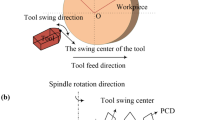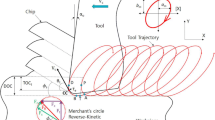Abstract
In micromachining, the quasi-intermittent vibration—assisted swing cutting technology alleviates the residual height problem of elliptical vibration–assisted cutting (EVC) and inherits its intermittent machining characteristics. The minimum chip thickness has a significant impact on cutting forces, tool wear, and process stability when working with difficult-to-machine materials. This study thoroughly examines the impact of cutting parameters and tool parameters on the quality of the workpiece during machining in order to better understand the time-varying characteristics of the quasi-intermittent vibration–assisted swing cutting (QVASC) machining process and the size effect on micro-cutting of silicon carbide crystal. This paper created the minimum chip thickness prediction model suited to QVASC machining process. The effects of variables such as cutting velocity and tool inclination on the minimum chip thickness were discussed as well as the scribing tests that were conducted on such challenging materials as silicon carbide. The research findings shown that during the machining process, the critical undeformed chip thickness of silicon carbide decreased continuously as the cutting velocity sequentially increased (1.51 mm/min, 1.88 mm/min, 2.26 mm/min); under the down inclination angle (0–10°), the critical undeformed chip thickness also continuously decreased. These results confirm that cutting too fast reduces the instantaneous undeformed chip thickness, which is not conducive to ductile removal.









Similar content being viewed by others
References
Lu M, Zhao D, Lin J, Zhou X, Zhou J, Chen B, Wang H (2018) Design and analysis of a novel piezoelectrically actuated vibration assisted rotation cutting system. Smart Mater Struct 27(9):095020
Zhu Z, Lu M, Lin J, Zhou J, Yi A, Zhuang X (2020) A tool path generation method for quasi-intermittent vibration assisted swing cutting. Proc Inst Mech Eng E: J Process Mech Eng 234(6):624–633
Bifano TG (1991) Ductile regime grinding: a new technology for machining brittle materials[J]. Trans ASME J Eng Ind 113:184
Stephenson DJ, Veselovac D, Manley S, Corbett J (2001) Ultra-precision grinding of hard steels. Precis Eng 25(4):336–345
Malekian M, Mostofa MG, Park SS, Jun MBG (2012) Modeling of minimum uncut chip thickness in micro machining of aluminum. J Mater Process Technol 212(3):553–559
Leksycki K, Feldshtein E, Królczyk GM, Legutko S (2020) On the chip shaping and surface topography when finish cutting 17–4 PH precipitation-hardening stainless steel under near-dry cutting conditions. Materials 13(9):2188
Yuan ZJ, Zhou M, Dong S (1996) Effect of diamond tool sharpness on minimum cutting thickness and cutting surface integrity in ultraprecision machining. J Mater Process Technol 62(4):327–330
Grzesik W (1996) A revised model for predicting surface roughness in turning. Wear 194(1–2):143–148
Grzesik W (1991) A real picture of plastic deformation concentrated in the chip produced by continuous straight-edged oblique cutting. Int J Mach Tools Manuf 31(3):329–344
Son S, Lim H, Ahn J (2006) The effect of vibration cutting on minimum cutting thickness. Int J Mach Tools Manuf 46(15):2066–2072
Son SM, Lim HS, Ahn JH (2005) Effects of the friction coefficient on the minimum cutting thickness in micro cutting. Int J Mach Tools Manuf 45(4–5):529–535
L’vov NP (1969) Determining the minimum possible chip thickness. Mach Tooling 4:40–45
Puttick KE, Rudman MR, Smith KJ, Franks A, Lindsey K (1989) Single-point diamond machining of glasses. Proc R Soc Lond A Math Phys Sci 426(1870):19–30
Schinker MG, Doll W (1987) Turning of optical glasses at room temperature. In In-Process Optical Metrology for Precision Machining. SPIE 802(1987):70–80
Venkatachalam S, Li X, Liang SY (2009) Predictive modeling of transition undeformed chip thickness in ductile-regime micro-machining of single crystal brittle materials. J Mater Process Technol 209(7):3306–3319
Przestacki D, Chwalczuk T, Wojciechowski S (2017) The study on minimum uncut chip thickness and cutting forces during laser-assisted turning of WC/NiCr clad layers. The International Journal of Advanced Manufacturing Technology 91:3887–3898
Liu X, DeVor RE, Kapoor SG (2006) An analytical model for the prediction of minimum chip thickness in micromachining. J Manuf Sci Eng Trans ASME 128:474–481
Johnson GR, Holmquist TJ (1992) A computational constitutive model for brittle materials subjected to large strains, high strain rates and high pressures. Shock wave and high-strain-rate phenomena in materials, 1075–1081
Johnson GR, Holmquist TJ (1994) An improved computational constitutive model for brittle materials. In: AIP conference proceedings. 309(1):981–984
Liu X, Jun MB, DeVor RE, Kapoor SG (2004) Cutting mechanisms and their influence on dynamic forces, vibrations and stability in micro-endmilling. In ASME International Mechanical Engineering Congress and Exposition 47136:583–592
Lu M, Guo M, Zhou J, Lin J, Xian J, Diao Y (2022) An analytical cutting force model of quasi-intermittent vibration assisted swing cutting based on predictive machining theory. Proc Inst Mech Eng C J Mech Eng Sci 236(7):3651–3662
Zhu D, Yan S, Li B (2014) Single-grit modeling and simulation of crack initiation and propagation in SiC grinding using maximum undeformed chip thickness. Comput Mater Sci 92:13–21
Pashmforoush F, Esmaeilzare A (2017) Experimentally validated finite element analysis for evaluating subsurface damage depth in glass grinding using Johnson-Holmquist model. Int J Precis Eng Manuf 18:1841–1847
Holmquist TJ, Johnson GR (2005) Characterization and evaluation of silicon carbide for high-velocity impact. J Appl Phys 97(9):093502
Funding
This work was supported by the National Natural Science Foundation of China (U21A20137), Natural Science Foundation of Jilin Province (YDZJ202201ZYTS534), Jilin Provincial International Cooperation Key Laboratory for High-Performance Manufacturing and Testing (20220502003GH), and Changchun Science and Technology Development Plan Project (21zgg08).
Author information
Authors and Affiliations
Contributions
Mingqi Guo: investigation, methodology, validation, writing — original draft, writing — review and editing; Lu Mingming: methodology, validation, experiments, writing — original draft, writing — review and editing; Jieqiong Lin: software, data curation; Gao Qiang: software, data curation; Yongshen Du: supervision, writing — review and editing.
Corresponding authors
Ethics declarations
Conflict of interest
The authors declare no competing interests.
Additional information
Publisher's note
Springer Nature remains neutral with regard to jurisdictional claims in published maps and institutional affiliations.
Rights and permissions
Springer Nature or its licensor (e.g. a society or other partner) holds exclusive rights to this article under a publishing agreement with the author(s) or other rightsholder(s); author self-archiving of the accepted manuscript version of this article is solely governed by the terms of such publishing agreement and applicable law.
About this article
Cite this article
Guo, M., Lu, M., Lin, J. et al. Modeling and investigation of minimum chip thickness for silicon carbide during quasi-intermittent vibration–assisted swing cutting. Int J Adv Manuf Technol 127, 1691–1701 (2023). https://doi.org/10.1007/s00170-023-11546-3
Received:
Accepted:
Published:
Issue Date:
DOI: https://doi.org/10.1007/s00170-023-11546-3




